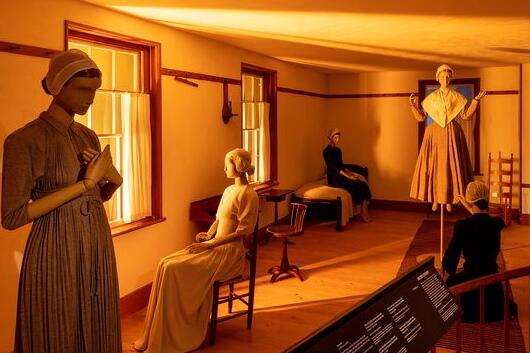‘In America: An Anthology of Fashion’ Review: Tableau Settings
In the Shaker Retiring Room at the Metropolitan Museum of Art—plaster walls the color of muslin, wood trim stained cherry, western light warming the windows—we see American values of material restraint and open space, circa 1835, in play. The room contains a few slat-back chairs, some small tables, a narrow bed, and for the next four months it is home to five mannequins dressed in Claire McCardell, whose midcentury monastic silhouettes are in accord with the Shaker imperative of clean, planed lines. You could be forgiven for thinking the sixth mannequin in the room also wears McCardell. But her shirtwaist of wool-silk weave, mantled in white cotton, is 1870 Shaker. She floats in midair, arms raised in mysterious transport, an incarnation.
This is the richest tableau in the exhibition “In America: An Anthology of Fashion,” the follow-up to last fall’s “In America: A Lexicon of Fashion” (recently refreshed and running in the downstairs galleries of the Costume Institute through Sept. 5). The new show, which begins in the late 1700s, places “narratives” about this country’s clothes in 13 of the museum’s 20 American period rooms. The garments have been chosen by Met curators Andrew Bolton, Jessica Regan and Amelia Peck, and the fictional tableaux have been staged by nine film directors.

Case Study, Gallery 723PHOTO: METROPOLITAN MUSEUM OF ART
For example, in the Shaker Retiring Room the story is told by Chloé Zhao, the Oscar-winning director of “Nomadland,” and it is many-leveled. That levitating Shaker woman isn’t only a symbol of spiritual rapture. She also recalls the hair-shirt hysteria of 1690s Salem, its rising visions of spectral witches. And the spacing of the mannequins reminds us of photographs by Deborah Turbeville, who in the 1970s grouped women in similarly abstract scenes of inward thought.
Mr. Bolton, the Costume Institute’s curator in charge, has frequently expanded his exhibitions into other Met spaces, but this time the challenges are trickier. Because the period rooms don’t always follow contiguously, they are connected here by what the curators call “case studies”—important pieces highlighted in vitrines. These work well, emphasizing a theme that flows through the show: the growing realization that America could reject Europe and develop its own design. All the rooms except one, however, are 19th century, and yet they’re often filled with designs from the mid-20th century. This can feel incoherent. It is the film directors who must square the circle, as Ms. Zhao did.

Tom Ford’s installation in the Vanderlyn PanoramaPHOTO: METROPOLITAN MUSEUM OF ART
The exhibition begins powerfully, with four case studies at the entrance. There’s a brown wool cutaway coat that belonged to George Washington, its austere curves recalling the Durham boat he used to cross the Delaware River, and a cream wool great coat from Brooks Brothers, made around 1860 as livery for an enslaved servant. An Abolition quilt of 1853 honors George Washington while chastising him for furthering the “monstrous, hideous blot” of slavery. Most profoundly, we’re shown the historic black wool broadcloth, also from Brooks Brothers, that Abraham Lincoln wore at his second inauguration, in 1865, and 41 days later on the night he was assassinated. These four pieces speak of America’s founding, its sin, its hope, its division.
In the period-room scenes that follow, some directors do better than others. Having a field day in the oval space that contains John Vanderlyn’s wraparound oil painting “Panoramic View of the Palace and Gardens of Versailles” (1818-19), the designer and director Tom Ford restages 1973’s “Battle of Versailles”—a fashion show that saw American ready-to-wear designers Bill Blass, Stephen Burrows, Halston, Anne Klein and Oscar de la Renta competing against five Paris couturiers and winning. Mirror-silver mannequins tumble and fly in a flashy mix of aerial fencing and martial-arts moves. In the face-off between a red chiffon Saint Laurent and a garnet Halston, Mr. Ford gives Halston the point.

Julie Dash’s Renaissance Revival RoomPHOTO: METROPOLITAN MUSEUM OF ART
In the Renaissance Revival Room, Julie Dash brings a mystical dimension to the reality of Ann Lowe’s life as a black designer. Lowe clothed socialites and created Jackie Kennedy’s wedding dress yet was rarely publicized or even acknowledged. Look closely. The mannequins wearing Lowe are shadowed by masked figures cloaked in ethereal black veiling, a nod to the ancestral costumes of West Africa known as Egungun. The word translates as “power concealed,” and its meaning here is crystal clear. The long-invisible black presence in American fashion is the show’s other important theme.
Sofia Coppola gets an “F” for her two uninspired Gilded Age tableaux, which just stand there. For one of the rooms, she invited “It” art couple Rachel Feinstein and John Currin to craft the mannequins’ heads—lumpy faces like baked apples!—a further annoyance, though I suppose we should be grateful they didn’t also do the bodies.

Martin Scorsese’s Frank Lloyd Wright roomPHOTO: METROPOLITAN MUSEUM OF ART
Martin Scorsese handles the finale, the Frank Lloyd Wright lakefront living room (1912-14), and creates an elegant cocktail-hour homage to the 1945 movie “Leave Her to Heaven,” its plot driven by Gene Tierney’s borderline personality. But the fashion match is forced. Wright’s ethic of “organic simplicity” is alien to the Anglo-American couturier Charles James, represented by eight gowns that date from 1947 to 1957. James’s overwrought construction, a bit borderline itself, often stressed the fabric, fought it. Had he designed buildings, his work would never have met code. How thrilling it would have been to see a true American architect in this room—that genius of exploratory seams and effortless modernity, Geoffrey Beene.
